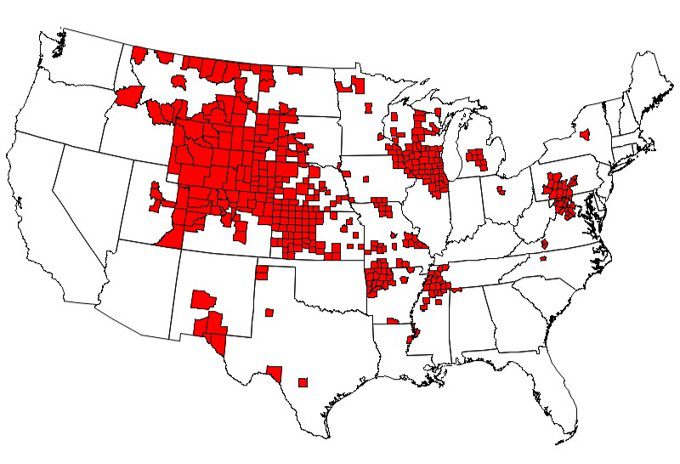The National Academies of Sciences, Engineering, and Medicine (NASEM) will review the state of knowledge about modes of transmission and means of geographic spread of chronic wasting disease (CWD) among free-ranging and captive populations of deer, moose and elk (cervids) in the United States.
CWD is a prion disease that affects deer, elk, reindeer, sika deer and moose. Prion diseases are caused by the abnormal folding of the prion proteins that form clumps in the brain. The disease was first detected in Colorado in 1967 and is thought to spread among cervids through contact with saliva and other fluids. It has now been found in some areas of North America, including Canada and the United States, Norway and South Korea.
It may take over a year before an infected animal develops symptoms, which can include drastic weight loss (wasting), stumbling, listlessness and other neurologic symptoms. CWD can affect animals of all ages and some infected animals may die without ever developing the disease. CWD is fatal to animals and there are no treatments or vaccines.

To date, there have been no reported cases of CWD infection in people. However, some animal studies suggest CWD poses a risk to certain types of non-human primates, like monkeys, that eat meat from CWD-infected animals or come in contact with brain or body fluids from infected deer or elk. These studies raise concerns that there may also be a risk to people.
The NASEM committee will assess the state of knowledge regarding: the infectious dose of CWD and different modes of disease transmission among cervids; the means of geographic spread through cervid dispersal, scavenger activity, and human actions; the effectiveness of interventions to reduce transmission and geographic spread of the disease.
In addition, the committee will consider the economic impacts of CWD and the effectiveness of different interventions to reduce those impacts.
NASEM is now accepting formal comments on the provisional committee selected for this report. The formal comment period on the provisional committee slate ends on October 9, 2023.
Sources: CDC, National Academies
READ ALSO:
Characterizing U.S. Agency Approaches to Cervid Carcass Disposal in the Context of Chronic Wasting Disease Management: A Multi-State, Mixed-Methods Analysis
Effective management and control of CWD is complicated by the unique ecology of CWD and, more specifically, CWD prions. Although the incubation period for CWD is often a year and a half or more, research indicates that infected, pre-symptomatic cervids actively shed CWD prions via bodily fluids, tissues, and waste—including saliva, urine, feces, blood, antler velvet, and semen—for most of that time, despite appearing and behaving healthy and normal. Furthermore, prions are notoriously resilient infectious agents. They are unaffected by common disinfectants such as formalin and alcohol and can withstand extreme temperatures (e.g., 600°C). Evidence indicates that the pathogenic prions causing scrapie—which are relatively analogous to CWD prions—can retain infectivity in the environment for at least 16 years. Such marked resilience of the prion agent helps facilitate indirect transmission of CWD, which occurs when a susceptible cervid ingests, inhales, or is otherwise exposed to contaminated material in the environment. Thus, any excreta (e.g., saliva, urine, feces) or tissues (e.g., carcasses) containing CWD prions that enter the environment could serve as a longstanding source of infection. ProQuest
Are Rapid Tests and Confirmatory Western Blot Used for Cattle and Small Ruminants TSEs Reliable Tools for Diagnosis of Chronic Wasting Disease in Europe?
The first case of CWD in Europe was detected in a Norwegian reindeer in 2016, followed later by two CWD cases in Norwegian moose. To prevent the potential spread of CWD to the EU, the European Commission (Regulation EU 2017_1972) implemented a CWD surveillance programme in cervids in the six countries having reindeer and or moose (Estonia, Finland, Latvia, Lithuania, Poland, and Sweden). Each country had to test a minimum of 3000 cervids for CWD using diagnostic rapid tests. Data on the performances of authorised rapid tests are limited for CWD (from North America) and are currently minimal for CWD from Europe, due to the paucity of positive material. The aim of this study was to evaluate the diagnostic performances of three of the so-called “rapid” tests, commercially available and approved for TSE diagnosis in cattle and small ruminants, to detect the CWD strains circulating in Europe. PLOS One
Fecal Microbiomics Biomarkers for Chronic Wasting Disease
Analysis of 50 fecal samples obtained from CWD-positive animals of different sexes from various regions in the US, compared to 50 healthy controls to identify CWD-dependent changes in the gut microbiome and the corresponding composition of key metabolites of host and microbial origin. These results point to microbial composition of the feces as a potential tool for diagnostics and surveillance of CWD in the wild, including non-invasive CWD detection in asymptomatic deer and deer habitats. BioRxiv
Efficacy of Wex-cide 128 Disinfectant Against Multiple Prion Strains
Prions are extremely difficult to inactivate and established methods to reduce prion infectivity are often dangerous, caustic, expensive, or impractical. Identifying viable and safe methods for treating prion contaminated materials is important for hospitals, research facilities, biologists, hunters, and meat-processors. For three decades, some prion researchers have used a phenolic product called Environ LpH (eLpH) to inactivate prions. ELpH has been discontinued, but a similar product, Wex-cide 128, containing the similar phenolic chemicals as eLpH is now available. This study directly compared the anti-prion efficacy of eLpH and Wex-cide 128 against prions from four different species. PLOS One


